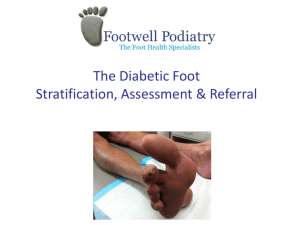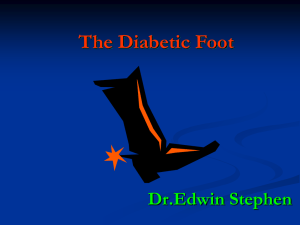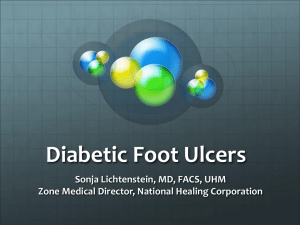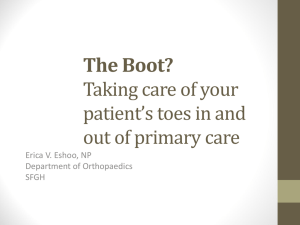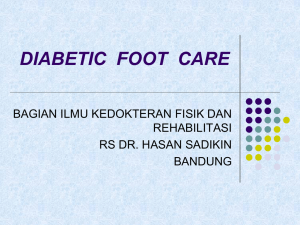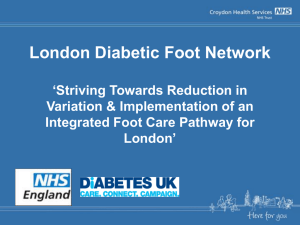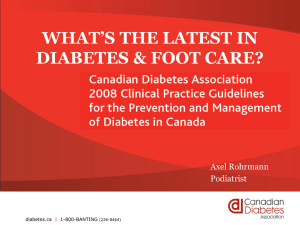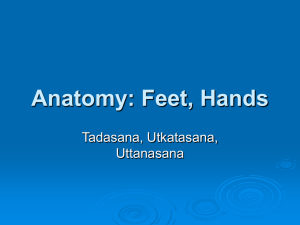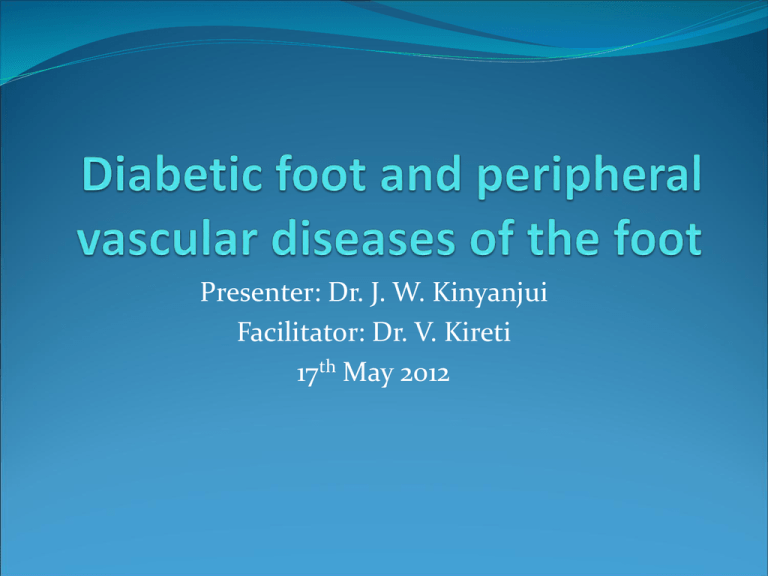
Presenter: Dr. J. W. Kinyanjui
Facilitator: Dr. V. Kireti
17th May 2012
Diabetic foot
Introduction
Diabetes mellitus is a group of metabolic diseases
characterized by hyperglycemia resulting from defects
in insulin secretion, insulin action, or both.
The chronic hyperglycemia of diabetes is associated
with long-term damage, dysfunction, and failure of
various organs, especially the eyes, kidneys, nerves,
heart, and blood vessels.
Diabetic foot is defined as any foot pathology that
results directly from diabetes or its long term
complications
Two types of diabetes: type I and type II diabetes
Epidemiology
Lesions of the feet affect approx 15% of diabetics in
their life with an amputation rate 15 fold higher than
non diabetics
Foot ulcerations are the commonest cause of hospital
admission in diabetics
Atherosclerosis rarely seen in type I diabetics < 40 yrs
while it may be present even before diagnosis in type II
A study conducted at KNH showed that diabetes
related gangrene was the indication in 17.5% of lower
limb amputations while PVD accounted for 55.3%
Epidemiology – risk factors
Male sex
DM > 10 years duration
Peripheral neuropathy
Abnormal foot structure
Peripheral arterial disease
Smoking
H/O previous ulceration / amputation
Poor glycemic control (HbA1c > 7%)
Pathophysiology
Factors leading to development of diabetic foot:
Diabetic macroangiopathy – peripheral arterial occlusive
disease
Diabetic microangiopathy – thickening of basement
membranes
Diabetic polyneuropathy
Diabetic osteoathropathy – abnormal foot biomechanics
Reduced resistance to infection
Delayed wound healing
Reduced rate of collateral vessel formation
Diabetic angiopathy
Diabetic macroangiopathy is histologically similar to
non diabetic atherosclerosis but distributed in the
distal segments of the lower extremities (calf and foot
arteries)
Arterial calcification readily detectable on plain x ray
with constriction noted on angiography. This
compromises oxygen supply to the periphery
Gas exchange is compromised by marked thickening
of the capillary basement membrane – a feature of
diabetic microangiopathy
Diabetic neuropathy
This affects the sensory, motor, and autonomic fibers
Sensory neuropathy - deep sensory perception is
reduced resulting in loss of protective reflexes against
physical injury. Typically, manifests in a sock - like
distribution.
Motor neuropathy – denervation and atrophy of small
foot muscles leading to malum perforans, transverse
foot arch instability with clawing and splay foot
Autonomic neuropathy – vasodilation and absent
sweating thus foot is warm, dry, scaly which
predisposes to fissure formation
Hammer toe
Claw toe
Hallux valgus, hammer toes, erythema over pressure points
Callus formation at pressure points and dry skin are substrate for ulceration
Pes cavus reulting in callus formation over the pressure points
Diabetic neuropathic
osteoarthropathy (DNOAP)
Destruction of peripheral and autonomic nerves leads to
vasodilation and subsequent demineralization and
destabilization of foot skeleton
Sander’s classification based on the location of the lesions in the
foot
DNOAP I – necrosis of metatarsophalengeal joints with eventual
malum perforans, osteolysis and candystick deformities
DNOAP II – necrosis of the tarsometatarsal joints (Lisfranc’s
joint) resulting in a destabilized backfoot. Subluxation of the
navicular leads to a clubfoot with abduction of the forefoot and
rocking foot deformity. Exposure of the cuneiform-naviculare
joint may lead to ulceration at this location
DNOAP I
Central malum perforans – MT I and IV
Osteolysis MT II
Candystick deformity MT III
DNOAP II
Ulceration over the navicular-cuneiform joint
Destruction of lisfranc articulations
Fallen medial arch with navicular subluxation
DNOAP
DNOAP III – necrosis of Chopart’s joint: talo-navicular
articulation. Leads to rocking foot deformity where the
middle of the sole becomes exposed to pressure.
Ulceration occurs directly beneath the verticalized
talus. There is as well broadening of the backfoot,
abduction of the forefoot and talonavicular
subluxation.
DNOAP IV – necrosis of the tibiotalar joint.
DNOAP V – necrosis of the talocalcaneal resulting in a
clump backfoot with the bayonet type of deformity.
DNOAP III
Ulceration over the navicular
Verticalisation of the talus
Navicular subluxation
Destruction of talonavicular articultaion
DNOAP IV
Destruction of tibiotalar
joint
Lateral malleolar
prominence at risk of
ulceration
DNOAP V
Bayonet deformity
Lateral skin ulceration risk
Destruction of talo- calcaneal joint
Increased infection rate
Skin fissurations predisposes to penetration of
infectious microbes
Polymorphonuclear granulocyte chemotaxis and
phagocytosis is impaired
Polyneuropathy predisposes to deep seated infections
due to impaired pain sensation
Both anaerobe and aerobe infections are implicated in
diabetic foot infections
Patient evaluation
Examination
Vascular Examination
◦
◦
◦
◦
◦
Palpation of pulses
Skin/limb colour changes
Presence of edema
Temperature gradient
Skin changes
Abnormal wrinkling
Absence of hair
Onychodystrophy
◦ Venous filling time
Neurological examination
◦ Vibration perception –
tuning fork at 128 Hz
◦ Light pressure - Simmes –
Weinstein 10 gram
monofilament
◦ Light touch
◦ Two point discrimination
◦ Pain
◦ Temperature perception
◦ Deep tendon reflexes
◦ Clonus
◦ Babinski test
◦ Romberg test
Examination
Dermatological
◦
◦
◦
◦
◦
◦
Skin appearance
Calluses
Fissures
Nail appearance
Hair growth
Ulceration/infection/
gangrene
◦ Interdigital lesions
◦ Tinea pedis
◦ Markers of diabetes
Musculoskeletal
◦ Biomechanical
abnormalities
◦ Structural deformities
◦ Prior amputation
◦ Restricted joint mobility
◦ Tendo Achilles
contractures
◦ Gait evaluation
◦ Muscle group strength
testing
◦ Plantar pressure
assessment
Classification - Wagner
Grade 0 - Skin intact, no foot deformity
Grade 1 - Superficial ulcer
Grade 2 - Deep ulcer
Grade 3 - Deep ulcer with infection
Grade 4 - Limited necrosis
Grade 5 - Necrosis of the entire foot
Wagner grade 0
Wagner grade 1
Wagner grade 2
Wagner grade 3
Wagner grade 4
Wagner grade 5
University of Texas grading
Based on wound ulcer depth and vascular status
Horizontal component:
Stage A – clean wounds
Stage B – non-ischemic infected
Stage C – ischemic non-infected
Stage D – ischemic, infected
Vertical component:
Grade 0 – pre- or postulcerative site that has healed
Grade 1 – superficial wound not involving tendon, capsule or
bone
Grade 2 – wound penetrating to tendon or capsule
Grade 3 – wound penetrating bone or joint
Laboratory evaluation
FBS/RBS
Glycosylated hemoglobin (HbA1C)
FHG + ESR
Wound and Blood cultures
Serum Chemistry: CRP
Urinalysis
Imaging
Plain X-rays
- Osteomyelitis, fractures
- Soft tissue gas
- Dislocations in neuropathic arthropathy
CT Scan
Technetium bone scans - osteomyeletis
MRI - osteomyelitis
Diabetic foot infection
Divided into uncomplicated non limb threatening
infection - superficial cellulitis of limited extension
that can be treated on an outpatient basis
Complicated limb threatening infections are more
extended and penetrate to deeper tissues, such as
tendons, joint capsules, bone or articulations. They
require inpatient treatment with surgical debridement
and intravenous antibiotics
Osteomyelitis has therapeutic implications such as
prolonged antibiotic courses and need for resections
Diabetic foot infection
Superficial swabs overestimate the number of likely
microorganisms therefore a deep tissue specimen is
preferred as it is more representative
Aerobic gram +ve cocci most common infecting
organisms: S. aureus and β-hemolytic streptococci
(especially group B)
Chronic wounds have more complex flora: enterococci,
enterobactereciae, obligate anaerobes, P. aeuroginosa
and other non-fermentative gram negative rods
Management
Preventative foot care
Diabetic foot ulcer (DFU) care
Ischemia management
Neuropathy management
Surgery
Preventative foot care
Podiatry - Regular inspection of the foot, appropriate nail
care, warm (32oC) soaks, moisturizing creams, early
detection of new lesions
Optimally fitted footwear – well cushioned sneakers,
custom molded shoes
Pressure reduction – cushioned insoles, custom orthoses
Patient education — need for daily inspection and
necessity for early intervention, avoidance of barefoot
walking
Physician education — significance of foot lesions,
importance of regular foot examination, and current
concepts of diabetic foot management
DFU care
Debridement – of callus and necrotic tissue using sharp
debridement till bleeding tissue, lavage and dressings
Offloading of the ulcer site to reduce ischaemia via total
contact cast, non weight bearing (crutches, bedrest, wheel
chair)
Wound management – maintenance of a moist wound
with regular cleaning and dressing
Infections treated with broad spectrum antibiotics based
on culture results.
Clindamycin/flouroquinolone/metronidazole suitable
empiric therapy
Ischemia/neuropathy
Angiography evaluates for chance of catheter
intervention or vascular surgery
Vascular bypass surgery successful if occlusion is
supramalleolar but less so in inframalleolar PAOD
Aspirin is useful for primary and secondary prevention
Neuropathy treated pharmacologically with agents
such as carbamazepine, gabapentin and pregabalin
and prevention of minor trauma that will go
undetected due to insensate foot
Surgery
Sharp debridement
Local procedures to remove areas of chronically
elevated pressure (deformities) causing non healing
ulcers
Sequestrectomies
Amputation
Correct structural deformities — hammer toes,
bunions, Charcot
Indications for amputation
Uncontrollable infection or sepsis
Inability to obtain a plantar grade, dry foot that can
tolerate weight bearing
Non ambulatory patient
Other peripheral vascular diseases
Peripheral arterial occlusive disease (PAOD)
Post thrombotic syndrome
Chronic venous insufficiency
PAOD
Most common cause is atheroclerosis which narrows the lumen
of peripheral arteries
Buerger’s disease is a potentially preventable cause due to its
association with smoking
Symptoms include:
Intermittent claudication
Ischaemic rest pain
Signs include:
Calf muscles atrophy
Loss of hair growth over the dorsum of the toes
Thickening of the toenails
Atrophy of the skin
Delayed capillary refill
Ischaemic ulcers
PAOD
Ischemic ulcers are painful with a ‘punched out’
appearance.
They are commonly located distally over the dorsum of
the foot or toes.
The ulcer base usually consists of poorly developed,
grayish granulation tissue.
Critical limb ischaemia is defined as persistent
ischemic rest pain lasting for more than 2 weeks
and/or ulceration of the leg, associated with an ankle
systolic pressure < 50 mm Hg and/or a toe systolic
pressure of <30 mm Hg and or an ABPI < 0.9.
PAOD - Investigations
Ankle systolic pressure measurement – 12cm cuff used and
doppler probe over the dorsalis pedis or posterior tibial artery.
<50mmHg implies critical limb ischemia and aggressive
revascularisation needed
Toe systolic pressure – 25mm cuff over proximal phalanx of
hallux. Critical limb ischemia at < 30mmHg
Transcutaneous oxygen pressure – electronic probe used. Normal
range 30 – 50 mmHg. < 30 mmHg implies critical ischaemia
Doppler ultrasound – operator dependent. More accurate for
assessment of femoropopliteal vessels than tibioperoneal arteries
Arteriography – gold standard, invasive, contrast used. Useful
where vascular procedures are being planned
Management of PAOD
Secondary prevention – statins, aspirin, DM and HTN
control, smoking cessation
Walking excersises 1h/day– reduced intermittent
claudication by encouraging collateral vessel formation
Footwear fitted to reduce pressure and increased warmth.
May need to be customised. Minimise exposure to cold and
mositure
Surgical debridement of ulcers with appropriate dressing
thereafter, infection control
Interventional vascular procedures such as percutaneous
transluminal angioplasty, bypass procedures indicated in
critical limb ischaemia
Amputation may eventually be necessary
Post thrombotic syndrome
Symptoms and signs that typically follow DVT
Caused by post thrombotic recanalisation and valve
destruction that leads to chronic ambulatory venous
hypertension
Not limb threatening but adversely affects quality of life
Symptoms include chronic leg discomfort
Signs include:
Edema
skin changes – pigmentation, dermatitis, liposclerosis
Ulcers – typically supramalleolar medial, painless, irregular
edges
Management
Primary prevention by preventing DVT in at risk patients
Early management of DVT and continued antithrombotic
therapy to prevent recurrence of DVT
Fibrinolysis and thrombectomy – controversial due to
minimal benefit and increased risk
Compression therapy – effective primary prevention of
DVT and secondary prevention of PTS after DVT. Layered
compression stockings now the mainstay of treatment
Vascular surgery – not as useful as in varicose veins because
PTS is a disease of the deep system
Chronic venous insufficiency
Chronic venous insufficiency (CVI) affects 10-15% of
men and 20-25% of women
Characterised by chronic inadequate drainage of
venous blood and venous hypertension, which results in
leg edema (swelling)
dermatosclerosis (hardening of the skin)
Feelings of pain, fatigue and tenseness in the lower
extremities
May be complicated by
skin ulceration
chronic (and potentially life-threatening) infections
of the lower extremities
Pathophysiology
Macrovascular changes – superficial and deep venous
reflux due to valve incompetency, failure of calf muscle
pump, deep vein occlusion and lack of valve patency
Microvacular changes:
fibrin cuff theory: extravasation of fibrin causing local
ischaemia
White cell trapping theory: trapped white cells activated
causing local tissue ischaemia
Growth factor trapping theory: impaired diffusion of growth
factors impairing healing
Cutaneous iron overload: iron in bivalent form accumulates
and promotes local tissue damage
CEAP classification
Based on:
Clinical severity
Etiology
Anatomy
Pathophysiology
Clinical severity
Class 0 – no visible or palpable signs of venous disease.
Class 1: Telangiectasis or reticular veins.
Class 2: Varicose veins.
Class 3: Edema.
Class 4: Skin changes e.g. venous eczema,
pigmentation and lipodermatosclerosis.
Class 5: Skin changes with healed ulceration
Class 6: Skin changes with active ulceration
Etiology, anatomy, Pathophysiology
Etiology:
Congenital
Primary (undetermined cause)
Secondary:
Post-thrombotic
Post-traumatic
Anatomy:
Superficial
Perforator
Deep
Pathophysiology:
Reflux
Obstruction
Reflux and obstruction
CVI – history and examination
History of :
• D.V.T.
• Peripheral arterial disease
• Medical problems:- diabetes
Examination for
• varicose veins
• Skin change:- edema-pigmentation-ulcer{above medial
malleolus}
• Peripheral pulses record
• Full neurological examination
• sensory deficit
• reduced movement
Investigations
Doppler ultrasound – available, safe, operator
dependent
Venography – gold standard, invasive, contrast use
Management
Conservative:
Elevation
Graduated elastic stockings
layered compression
Dressings
stockings
Antibiotics in infections
Surgery:
Debridement of ulcers
Skin grafts and flaps
Superficial vein surgery – stripping
Perforator ligation
Deep venous reconstruction: valvuloplasty, bypass operations,
endovascular procedures
THANK YOU



